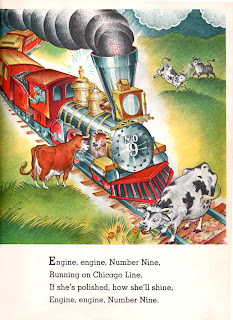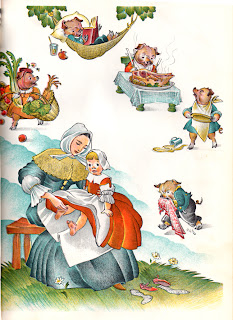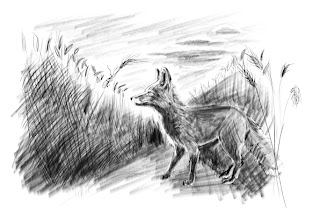In the world of movies and television, we can all think of husband and wife partnerships that produced fruitful collaborations, Burns and Allen, Lucy and Desi, Bogart and Bacall, the list goes on, but there is another artistic field where wife and husband teams have also produced a lasting legacy. Since I primarily write about children's books in this blog, you can probably guess that the artistic field that I'm talking about is children's book illustration. The world of children's books has given us Berta and Elmer Hader (The Big Snow, 1948), Alice and Martin Provensen (The Glorious Flight, 1983; A Child's Garden of Verses, 1951), Leo and Dianne Dillon (The People Could Fly, 1985) and Maud and Miska Petersham (Poppy Seed Cakes, 1924, The Rooster Crows: A Book of American Rhymes and Jingles, 1945). It is the Petershams that I'm featuring in this posting, primarily because I recently acquired two of their books at used book sales.
The Petershams illustrated many wonderful books in a period that lasted for over thirty years, primarily between the 1920s and 1950s. Maud was born in 1889 and was a New York native, while her husband Miska immigrated to the United States from Hungary in 1912. They met in an art school in New York City, were married and began collaborating on children's books. The first book that they not only illustrated but also wrote, was "Miki" (1929), which according to Anita Silvey's "Children's Books and Their Creators," was "the first big colored picture book printed in the United States, and the first of a tide of pictures books set in a foreign land."
As I mentioned earlier, I recently acquired two of the Petershams' books - their illustrated version of the combined "Rip Van Winkle and The Legend of Sleepy Hollow," published by The Macmillan Company in 1951, and their 1946 Caldecott Medal winner, "The Rooster Crows: A Book of American Rhymes and Jingles." The illustrations in these two books couldn't be more different, one done in pen and ink, and the other in what looks to be lithographs. The Petershams were known for their depictions of European traditions and old world cultures so their pen and ink illustrations for "Rip Van Winkle and The Legend of Sleepy Hollow," were a perfect fit. The Petershams lived in the area where Irving's stories were set and their illustrations beautifully capture the craggy hills, the crooked trees and the natural beauty of a part of New York that was once a Dutch settlement. I think you'll agree that their depiction of Ichabod Crane is a wonderful match for Irving's description of the character,"His head was small, and flat at top, with huge ears, large, green, glassy eyes, and a long, snip nose, so that it looked like a weather-cock perched upon his spindle neck to tell which way the wind blew. To see him striding along the pofile of a hill on a windy day, with his clothes bagging and fluttering about him, one might have mistaken him for the genius of Famine descending upon the earth or some scarecrow eloped from a cornfield."
"The Rooster Crows: A Book of American Rhymes and Jingles," was published in 1945 and as I mentioned earlier, won the 1946 Caldecott Medal. As an interesting side note, according to Anita Silvey, later editions of this book had two rhymes and their accompanying illustrations removed due to the fact that they contained offensive black stereotypes. The edition that I recently found at a library sale, and that I am featuring in this blog, is a later edition without the offending rhymes, so I will reserve comment on what was omitted. "The Rooster Crows," as its subtitle states, features all sort of rhymes and jingles, some of them familiar like "How much wood would a woodchuck chuck...," and some not so familiar "Bat, bat, come under my hat, and I'll give you a slice of bacon."
The illustrations are all delightful with a mix of contemporary (contemporary to the 1940s that is) settings and earlier time periods that look to be close to the era in which "The Legend of Sleepy Hollow" is set. I love this illustration for "Star bright, star light," (see above right) where the artists have chosen to make the earthbound portions of the rhyme, more fantastical than the starry night. If you look closely you'll see that the young girl is surrounded by some fantasy fireflies, each one carrying a little lantern. It's a good example of how an illustrator can bring something to an illustration that is not mentioned in the text.
This beautiful color illustration for the rhyme "Red at night, Sailors delight. Red in the morning, Sailors take warning," is one of my favorites. I love how they have split the scene in two, one side bright and cheerful, the other blue and stormy. The two different sides are tied together by the rhythmic, almost art deco waves. By showing a sailor facing the ocean, with a caged parrot in one hand and a duffel bag in the other, the artists have given this short little saying a narrative that goes beyond its four lines of text.
 Another of my favorites, is this one for the rhyme, "Engine, engine, Number Nine." This is a jingle that I remember from childhood, and I love how the Petershams have illustrated the last part of the rhyme "If she's polished how she'll shine," by showing a cow looking at its reflection in the shiny engine's surface.
Another of my favorites, is this one for the rhyme, "Engine, engine, Number Nine." This is a jingle that I remember from childhood, and I love how the Petershams have illustrated the last part of the rhyme "If she's polished how she'll shine," by showing a cow looking at its reflection in the shiny engine's surface. This illustration of a young girl testing the waters of a stream, is another example of how the artists have used their imagination to supplement the limited text. I love all of the little animals that are in the scene, none of which are mentioned in the rhyme.
This illustration of a young girl testing the waters of a stream, is another example of how the artists have used their imagination to supplement the limited text. I love all of the little animals that are in the scene, none of which are mentioned in the rhyme.I'm sure most of us can remember having a parent count out our toes using the "This little piggy went to market" rhyme. Here the Petershams show us a mother in 18th or possibly early 19th century costume, counting out the rhyme on her little girl's toes, while above them we are shown what each of the little pigs is doing.
I was delighted to find these two books illustrated by the Petershams and they have made me want to check out more of their illustrious output.
































